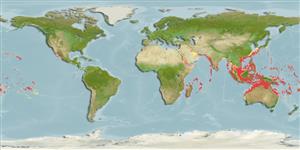Environment: milieu / climate zone / depth range / distribution range
Écologie
marin récifal; profondeur 0 - 200 m (Ref. 37816). Tropical
Indo-Pacific: East Africa to Micronesia, north to Taiwan, south to Australia (Ref. 1602); including Society Is. (Ref. 86966).
Taille / Poids / Âge
Maturity: Lm ? range ? - ? cm
Max length : 13.0 cm TL mâle / non sexé; (Ref. 48635)
Épines dorsales (Total) : 13; Rayons mous dorsaux (Total) : 8 - 9; Épines anales: 3; Rayons mous anaux: 5. Pored lateral scale counts from Ref. 1602.
Found in various reef habitats in shallow coastal lagoons to moderate depths on outer reefs; in sponges (Ref. 48635) and coralline areas (Ref. 2334). Benthic (Ref. 75154).
Life cycle and mating behavior
Maturité | Reproduction | Frai | Œufs | Fécondité | Larves
Randall, J.E., G.R. Allen and R.C. Steene, 1990. Fishes of the Great Barrier Reef and Coral Sea. University of Hawaii Press, Honolulu, Hawaii. 506 p. (Ref. 2334)
Statut dans la liste rouge de l'IUCN (Ref. 130435: Version 2024-1)
Menace pour l'homme
Harmless
Utilisations par l'homme
Pêcheries: sans intérêt
Outils
Articles particuliers
Télécharger en XML
Sources Internet
Estimates based on models
Preferred temperature (Ref.
123201): 21.7 - 28.2, mean 26.5 °C (based on 681 cells).
Phylogenetic diversity index (Ref.
82804): PD
50 = 0.5000 [Uniqueness, from 0.5 = low to 2.0 = high].
Bayesian length-weight: a=0.01288 (0.00620 - 0.02676), b=3.03 (2.86 - 3.20), in cm total length, based on LWR estimates for this (Sub)family-body shape (Ref.
93245).
Niveau trophique (Ref.
69278): 3.6 ±0.5 se; based on size and trophs of closest relatives
Résilience (Ref.
120179): Haut, temps minimum de doublement de population inférieur à 15 mois (Preliminary K or Fecundity.).
Fishing Vulnerability (Ref.
59153): Low vulnerability (10 of 100).
Nutrients (Ref.
124155): Calcium = 84.3 [41.7, 195.7] mg/100g; Iron = 0.706 [0.379, 1.784] mg/100g; Protein = 18 [16, 20] %; Omega3 = 0.274 [0.119, 0.773] g/100g; Selenium = 33.5 [17.1, 81.7] μg/100g; VitaminA = 160 [54, 445] μg/100g; Zinc = 1.53 [1.04, 2.21] mg/100g (wet weight);
